Adventure Travel · Cruises & Boat Travel · Ecuador · Leisure Travel · Regions · South America · Speciality Travel
15 reasons to visit the Galápagos Islands
The Galapagos are 16 volcanic islands and hundreds of islets in the middle of the Pacific Ocean straddling the equator 950 km from the South American coast. Our five day cruise was on La Pinta, a ship accommodating just 48 guests accompanied by 4 experienced Naturalist Guides hosting excursions during the day and presentations on Darwin’s theory of evolution in the evening.
 Darwin was just 22 when brought in as first reserve to join the ship Beagle as an unpaid naturalist for a 5 year voyage starting in December 1831. He was seasick all the way and tried to jump ship at Tenerife, but they wouldn’t let him. The summary of his 500 page book “On the Origin of Species by Means of Natural Selection” is cleverly described on a tee-shirt I bought at the small airport; “It is not the strongest of the species that survives, nor the most intelligent. It is the one that is the most adaptable to change.”
The wildlife on the islands has virtually no predators on land, very few of the indigenous species do, that’s partly why we can interact with them so easily. To say they are tame gives the wrong impression, they have just never learned to be fearful of humans. It is indicative of the diverse wildlife on the archipelago that safaris have their Big 5 but the Galapagos has its Big 15 – we went in search of the 15 great reasons to visit this extraordinary location.
1. Galapagos albatross
The giant of them all, the Galapagos albatross has a wingspan of over 8 feet, weighs up to 5 kg and can live for over 45 years. They are found on only one of the Galapagos islands – Espanola but can be seen elegantly gliding across the Pacific searching for food.
Darwin was just 22 when brought in as first reserve to join the ship Beagle as an unpaid naturalist for a 5 year voyage starting in December 1831. He was seasick all the way and tried to jump ship at Tenerife, but they wouldn’t let him. The summary of his 500 page book “On the Origin of Species by Means of Natural Selection” is cleverly described on a tee-shirt I bought at the small airport; “It is not the strongest of the species that survives, nor the most intelligent. It is the one that is the most adaptable to change.”
The wildlife on the islands has virtually no predators on land, very few of the indigenous species do, that’s partly why we can interact with them so easily. To say they are tame gives the wrong impression, they have just never learned to be fearful of humans. It is indicative of the diverse wildlife on the archipelago that safaris have their Big 5 but the Galapagos has its Big 15 – we went in search of the 15 great reasons to visit this extraordinary location.
1. Galapagos albatross
The giant of them all, the Galapagos albatross has a wingspan of over 8 feet, weighs up to 5 kg and can live for over 45 years. They are found on only one of the Galapagos islands – Espanola but can be seen elegantly gliding across the Pacific searching for food.
 2. Blue-footed booby
One of three boobies found on the Galapagos, they have bright blue feet due to the collagen in their fish diet. Their name comes from ‘bobo’ the Spanish word for clown due to their clumsiness on land. But in the air they are spectacular to watch as they fish in groups of over 100.
2. Blue-footed booby
One of three boobies found on the Galapagos, they have bright blue feet due to the collagen in their fish diet. Their name comes from ‘bobo’ the Spanish word for clown due to their clumsiness on land. But in the air they are spectacular to watch as they fish in groups of over 100.
 3. Nazca booby
Unlike its colourful footed cousins the Nazca booby has an elegant white plumage, a bright orange bill and dull grey feet. It is relatively new to the official Big 15 having only been discovered to be its own species in 2002.
3. Nazca booby
Unlike its colourful footed cousins the Nazca booby has an elegant white plumage, a bright orange bill and dull grey feet. It is relatively new to the official Big 15 having only been discovered to be its own species in 2002.
 4. Red-footed booby
Their usual dull grey plumage is more than made up for by their bright red feet and blue bills. They can be found fishing around the islands of Genovesa and San Cristobal. Once a school of fish is spotted they dive from 10 metres or more, entering the water at 60 mph to catch their prey – they have an air sack in their head to cushion the impact with the water.
4. Red-footed booby
Their usual dull grey plumage is more than made up for by their bright red feet and blue bills. They can be found fishing around the islands of Genovesa and San Cristobal. Once a school of fish is spotted they dive from 10 metres or more, entering the water at 60 mph to catch their prey – they have an air sack in their head to cushion the impact with the water.
 5. Flightless cormorant
We spotted the flightless cormorants, another bird native to the Galapagos Islands and the only one of 29 cormorant species that cannot fly. Poor things look so sorry for themselves with their shrivelled wings, perched on the cliff rocks. Darwin would argue they didn’t need their wings because they have no predators on land and are better suited to swimming.
6. American flamingo
These beautiful birds are the most vivid pink and can be found in large colonies in the brackish shallow waters off many of the islands. They stand on one leg, with their drainpipe necks and feed on crustaceans, but oddly can only swallow with their heads upside down.
5. Flightless cormorant
We spotted the flightless cormorants, another bird native to the Galapagos Islands and the only one of 29 cormorant species that cannot fly. Poor things look so sorry for themselves with their shrivelled wings, perched on the cliff rocks. Darwin would argue they didn’t need their wings because they have no predators on land and are better suited to swimming.
6. American flamingo
These beautiful birds are the most vivid pink and can be found in large colonies in the brackish shallow waters off many of the islands. They stand on one leg, with their drainpipe necks and feed on crustaceans, but oddly can only swallow with their heads upside down.
 7. Frigatebirds
Living side by side with the boobies are literally hundreds of frigatebirds, wonderfully named the “Great Frigatebird” and “Magnificent Frigatebird”. They have the distinctive red pouch on their chest that inflates to attract females. They are large birds with black plumage to show off the red pouch, forked tails, long hooked bills and a 6 feet wingspan. They are able to soar for weeks on wind currents, and they can sleep on the wing.
7. Frigatebirds
Living side by side with the boobies are literally hundreds of frigatebirds, wonderfully named the “Great Frigatebird” and “Magnificent Frigatebird”. They have the distinctive red pouch on their chest that inflates to attract females. They are large birds with black plumage to show off the red pouch, forked tails, long hooked bills and a 6 feet wingspan. They are able to soar for weeks on wind currents, and they can sleep on the wing.
 8. Galapagos hawk
The Galapagos hawk can be up to 2 feet in height with a wingspan of around 4 feet. As the name suggests it is a unique species to the islands but due to a dwindling food supply, the introduction of new predators and human intervention they are now extinct on 5 of the main islands.
9. Land iguana
There are three iguanas in the Galapagos Big 15. The land iguanas are beautiful looking creatures in gold, orange, yellow and red about a metre long. They usually sit completely still soaking up the sun looking intently at observers in an inscrutable way, until they decide to go walk about and we all let them pass.
10. Marine iguana
There is a misconception that the prehistoric looking black marine iguana spit. On closer examination they’re not, they are sneezing salt. With the fish they eat they consume a lot of salt water as they swallow their prey, the salt is filtrated and held in glands behind their nose, they then lie on the rocks sneezing, thereby propelling their salty snot all over their companions on the warm lava stone.
8. Galapagos hawk
The Galapagos hawk can be up to 2 feet in height with a wingspan of around 4 feet. As the name suggests it is a unique species to the islands but due to a dwindling food supply, the introduction of new predators and human intervention they are now extinct on 5 of the main islands.
9. Land iguana
There are three iguanas in the Galapagos Big 15. The land iguanas are beautiful looking creatures in gold, orange, yellow and red about a metre long. They usually sit completely still soaking up the sun looking intently at observers in an inscrutable way, until they decide to go walk about and we all let them pass.
10. Marine iguana
There is a misconception that the prehistoric looking black marine iguana spit. On closer examination they’re not, they are sneezing salt. With the fish they eat they consume a lot of salt water as they swallow their prey, the salt is filtrated and held in glands behind their nose, they then lie on the rocks sneezing, thereby propelling their salty snot all over their companions on the warm lava stone.
 11. Santa Fe iguana
The Santa Fe land iguanas can weigh up to 11 kg and look like dragons. Although they are difficult to spot on their small home island of Santa Fe which is some distance from the other main islands it is well worth the trip.
12. Galapagos penguin
The rare Galapagos penguins are the only penguins that live on the equator, they can survive because they have adapted to the nutrient rich water in the archipelago. They can be seen on the rocks of the larger islands with their feet in the shade to avoid the heat absorbed by the black lava.
11. Santa Fe iguana
The Santa Fe land iguanas can weigh up to 11 kg and look like dragons. Although they are difficult to spot on their small home island of Santa Fe which is some distance from the other main islands it is well worth the trip.
12. Galapagos penguin
The rare Galapagos penguins are the only penguins that live on the equator, they can survive because they have adapted to the nutrient rich water in the archipelago. They can be seen on the rocks of the larger islands with their feet in the shade to avoid the heat absorbed by the black lava.
 13. Galapagos sea lion
The Galapagos sea lion is indigenous to the islands and can often be seen sun bathing on land, although usually on the shores and rocks not always on a comfortable park bench. The sea lion pups are very playful and would often join us in the water while we were snorkelling to play a game of hide-and-seek, swimming towards our masks and disappearing with a flash of their tails.
13. Galapagos sea lion
The Galapagos sea lion is indigenous to the islands and can often be seen sun bathing on land, although usually on the shores and rocks not always on a comfortable park bench. The sea lion pups are very playful and would often join us in the water while we were snorkelling to play a game of hide-and-seek, swimming towards our masks and disappearing with a flash of their tails.
 14. Galapagos fur seal
They are an endangered species and although the fur seal was close to extinction during the 1800’s due to hunting for their fur they are social animals and have no fear of man. They feed on fish and squid at night in depths of around 100 metres but oddly at full moon prefer to spend the night on land.
14. Galapagos fur seal
They are an endangered species and although the fur seal was close to extinction during the 1800’s due to hunting for their fur they are social animals and have no fear of man. They feed on fish and squid at night in depths of around 100 metres but oddly at full moon prefer to spend the night on land.
 15. Galapagos giant tortoise
The Galapagos giant tortoise is the largest living species of tortoise, weighing up to 65 stones.
The traditional tortoise we think of has a dome shell, adapted for wet zones where the food is close to the ground. But those ferried across to the Galapagos on floating vegetation where the terrain was just dust quickly devoured the low hanging fruit of the cactus and were unable to reach the branches, or pads, higher up.
15. Galapagos giant tortoise
The Galapagos giant tortoise is the largest living species of tortoise, weighing up to 65 stones.
The traditional tortoise we think of has a dome shell, adapted for wet zones where the food is close to the ground. But those ferried across to the Galapagos on floating vegetation where the terrain was just dust quickly devoured the low hanging fruit of the cactus and were unable to reach the branches, or pads, higher up.
 So, their shells adapted to remove the back collar and allow their neck to reach further up the cactus. They adapted to their environment and survived as a completely new species and are of course unique to the Galápagos.
A small group of us sat on the rocks in a bay on Isabela Island the largest of the Galapagos and shaped like a seahorse. We were waiting for the RIB to return as the sun set over the Pacific Ocean. There was a silence amongst us as we stared in awe at the beauty of these islands, their landscape and their inhabitants.
From our viewpoint we could see turtles, penguins, sea lions, dolphins, boobies, pelicans, frigatebirds, flightless cormorants and marine iguanas, all from that small cove, incredible. It was a poignant moment, but that’s what the Galápagos does to you, it is a beautiful and emotional experience, I wouldn’t have missed it for the world.
David Moore is Author of ‘Turning Left Around the World’. Published by Mirador and available from Amazon, it is an entertaining account of David and his wife’s travel adventures – often intriguing, frequently funny and occasionally tragic.
If you would like to be a guest blogger on A Luxury Travel Blog in order to raise your profile, please contact us.
So, their shells adapted to remove the back collar and allow their neck to reach further up the cactus. They adapted to their environment and survived as a completely new species and are of course unique to the Galápagos.
A small group of us sat on the rocks in a bay on Isabela Island the largest of the Galapagos and shaped like a seahorse. We were waiting for the RIB to return as the sun set over the Pacific Ocean. There was a silence amongst us as we stared in awe at the beauty of these islands, their landscape and their inhabitants.
From our viewpoint we could see turtles, penguins, sea lions, dolphins, boobies, pelicans, frigatebirds, flightless cormorants and marine iguanas, all from that small cove, incredible. It was a poignant moment, but that’s what the Galápagos does to you, it is a beautiful and emotional experience, I wouldn’t have missed it for the world.
David Moore is Author of ‘Turning Left Around the World’. Published by Mirador and available from Amazon, it is an entertaining account of David and his wife’s travel adventures – often intriguing, frequently funny and occasionally tragic.
If you would like to be a guest blogger on A Luxury Travel Blog in order to raise your profile, please contact us.
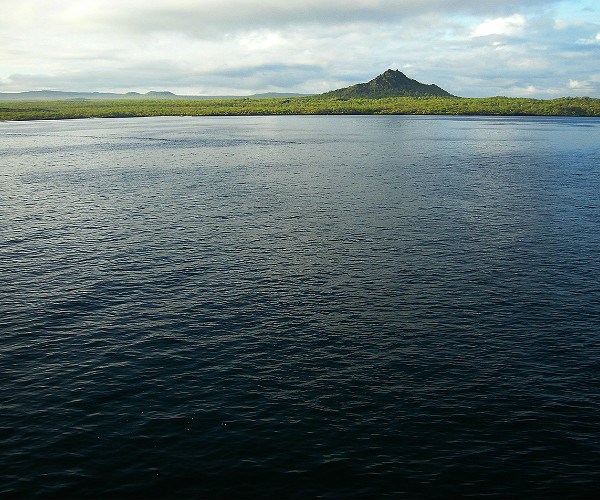 Darwin was just 22 when brought in as first reserve to join the ship Beagle as an unpaid naturalist for a 5 year voyage starting in December 1831. He was seasick all the way and tried to jump ship at Tenerife, but they wouldn’t let him. The summary of his 500 page book “On the Origin of Species by Means of Natural Selection” is cleverly described on a tee-shirt I bought at the small airport; “It is not the strongest of the species that survives, nor the most intelligent. It is the one that is the most adaptable to change.”
The wildlife on the islands has virtually no predators on land, very few of the indigenous species do, that’s partly why we can interact with them so easily. To say they are tame gives the wrong impression, they have just never learned to be fearful of humans. It is indicative of the diverse wildlife on the archipelago that safaris have their Big 5 but the Galapagos has its Big 15 – we went in search of the 15 great reasons to visit this extraordinary location.
1. Galapagos albatross
The giant of them all, the Galapagos albatross has a wingspan of over 8 feet, weighs up to 5 kg and can live for over 45 years. They are found on only one of the Galapagos islands – Espanola but can be seen elegantly gliding across the Pacific searching for food.
Darwin was just 22 when brought in as first reserve to join the ship Beagle as an unpaid naturalist for a 5 year voyage starting in December 1831. He was seasick all the way and tried to jump ship at Tenerife, but they wouldn’t let him. The summary of his 500 page book “On the Origin of Species by Means of Natural Selection” is cleverly described on a tee-shirt I bought at the small airport; “It is not the strongest of the species that survives, nor the most intelligent. It is the one that is the most adaptable to change.”
The wildlife on the islands has virtually no predators on land, very few of the indigenous species do, that’s partly why we can interact with them so easily. To say they are tame gives the wrong impression, they have just never learned to be fearful of humans. It is indicative of the diverse wildlife on the archipelago that safaris have their Big 5 but the Galapagos has its Big 15 – we went in search of the 15 great reasons to visit this extraordinary location.
1. Galapagos albatross
The giant of them all, the Galapagos albatross has a wingspan of over 8 feet, weighs up to 5 kg and can live for over 45 years. They are found on only one of the Galapagos islands – Espanola but can be seen elegantly gliding across the Pacific searching for food.
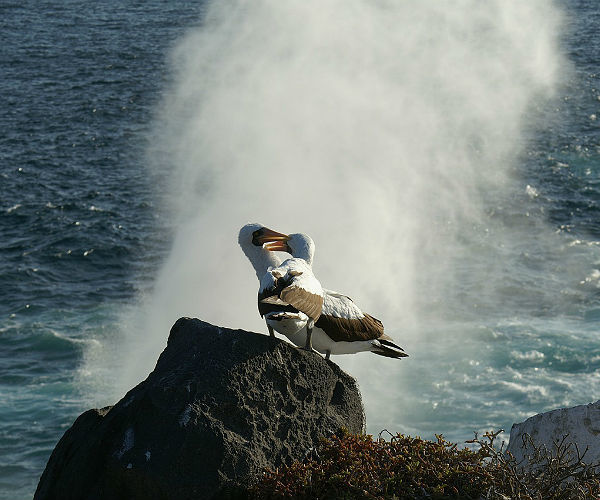 2. Blue-footed booby
One of three boobies found on the Galapagos, they have bright blue feet due to the collagen in their fish diet. Their name comes from ‘bobo’ the Spanish word for clown due to their clumsiness on land. But in the air they are spectacular to watch as they fish in groups of over 100.
2. Blue-footed booby
One of three boobies found on the Galapagos, they have bright blue feet due to the collagen in their fish diet. Their name comes from ‘bobo’ the Spanish word for clown due to their clumsiness on land. But in the air they are spectacular to watch as they fish in groups of over 100.
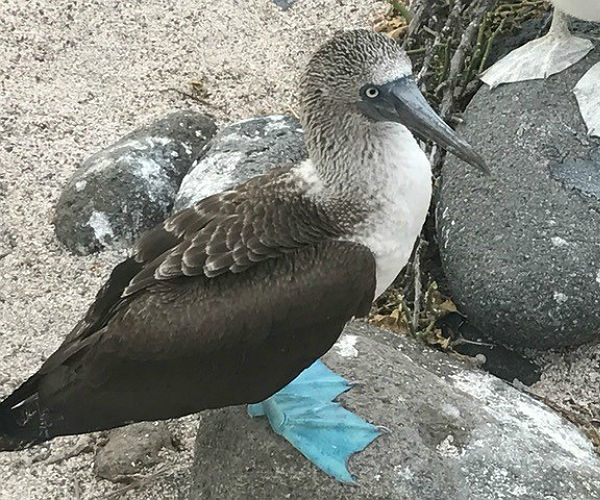 3. Nazca booby
Unlike its colourful footed cousins the Nazca booby has an elegant white plumage, a bright orange bill and dull grey feet. It is relatively new to the official Big 15 having only been discovered to be its own species in 2002.
3. Nazca booby
Unlike its colourful footed cousins the Nazca booby has an elegant white plumage, a bright orange bill and dull grey feet. It is relatively new to the official Big 15 having only been discovered to be its own species in 2002.
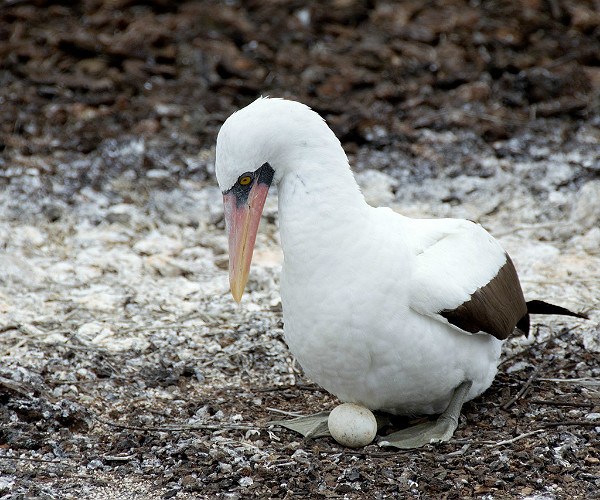 4. Red-footed booby
Their usual dull grey plumage is more than made up for by their bright red feet and blue bills. They can be found fishing around the islands of Genovesa and San Cristobal. Once a school of fish is spotted they dive from 10 metres or more, entering the water at 60 mph to catch their prey – they have an air sack in their head to cushion the impact with the water.
4. Red-footed booby
Their usual dull grey plumage is more than made up for by their bright red feet and blue bills. They can be found fishing around the islands of Genovesa and San Cristobal. Once a school of fish is spotted they dive from 10 metres or more, entering the water at 60 mph to catch their prey – they have an air sack in their head to cushion the impact with the water.
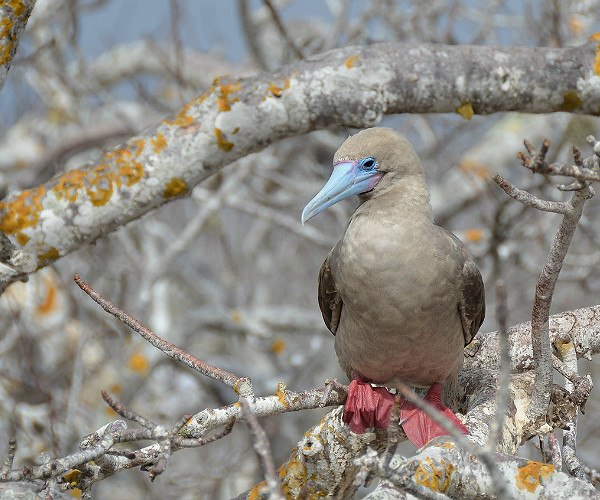 5. Flightless cormorant
We spotted the flightless cormorants, another bird native to the Galapagos Islands and the only one of 29 cormorant species that cannot fly. Poor things look so sorry for themselves with their shrivelled wings, perched on the cliff rocks. Darwin would argue they didn’t need their wings because they have no predators on land and are better suited to swimming.
6. American flamingo
These beautiful birds are the most vivid pink and can be found in large colonies in the brackish shallow waters off many of the islands. They stand on one leg, with their drainpipe necks and feed on crustaceans, but oddly can only swallow with their heads upside down.
5. Flightless cormorant
We spotted the flightless cormorants, another bird native to the Galapagos Islands and the only one of 29 cormorant species that cannot fly. Poor things look so sorry for themselves with their shrivelled wings, perched on the cliff rocks. Darwin would argue they didn’t need their wings because they have no predators on land and are better suited to swimming.
6. American flamingo
These beautiful birds are the most vivid pink and can be found in large colonies in the brackish shallow waters off many of the islands. They stand on one leg, with their drainpipe necks and feed on crustaceans, but oddly can only swallow with their heads upside down.
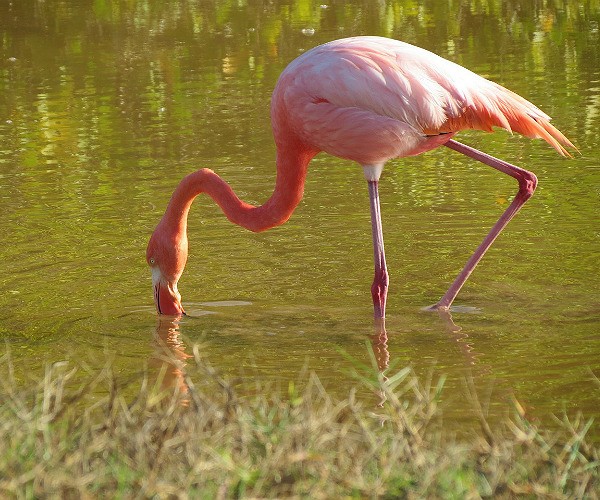 7. Frigatebirds
Living side by side with the boobies are literally hundreds of frigatebirds, wonderfully named the “Great Frigatebird” and “Magnificent Frigatebird”. They have the distinctive red pouch on their chest that inflates to attract females. They are large birds with black plumage to show off the red pouch, forked tails, long hooked bills and a 6 feet wingspan. They are able to soar for weeks on wind currents, and they can sleep on the wing.
7. Frigatebirds
Living side by side with the boobies are literally hundreds of frigatebirds, wonderfully named the “Great Frigatebird” and “Magnificent Frigatebird”. They have the distinctive red pouch on their chest that inflates to attract females. They are large birds with black plumage to show off the red pouch, forked tails, long hooked bills and a 6 feet wingspan. They are able to soar for weeks on wind currents, and they can sleep on the wing.
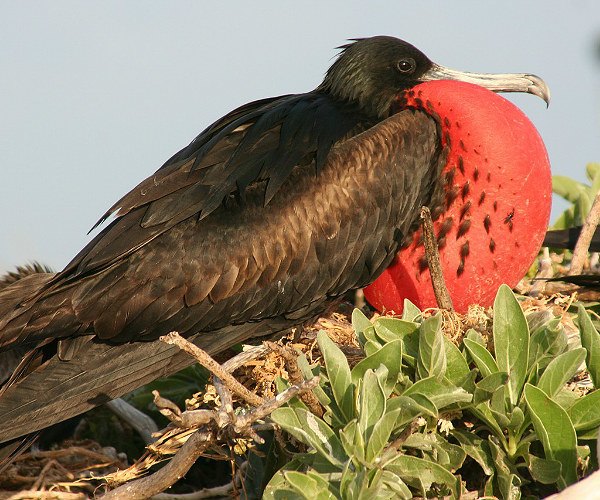 8. Galapagos hawk
The Galapagos hawk can be up to 2 feet in height with a wingspan of around 4 feet. As the name suggests it is a unique species to the islands but due to a dwindling food supply, the introduction of new predators and human intervention they are now extinct on 5 of the main islands.
9. Land iguana
There are three iguanas in the Galapagos Big 15. The land iguanas are beautiful looking creatures in gold, orange, yellow and red about a metre long. They usually sit completely still soaking up the sun looking intently at observers in an inscrutable way, until they decide to go walk about and we all let them pass.
10. Marine iguana
There is a misconception that the prehistoric looking black marine iguana spit. On closer examination they’re not, they are sneezing salt. With the fish they eat they consume a lot of salt water as they swallow their prey, the salt is filtrated and held in glands behind their nose, they then lie on the rocks sneezing, thereby propelling their salty snot all over their companions on the warm lava stone.
8. Galapagos hawk
The Galapagos hawk can be up to 2 feet in height with a wingspan of around 4 feet. As the name suggests it is a unique species to the islands but due to a dwindling food supply, the introduction of new predators and human intervention they are now extinct on 5 of the main islands.
9. Land iguana
There are three iguanas in the Galapagos Big 15. The land iguanas are beautiful looking creatures in gold, orange, yellow and red about a metre long. They usually sit completely still soaking up the sun looking intently at observers in an inscrutable way, until they decide to go walk about and we all let them pass.
10. Marine iguana
There is a misconception that the prehistoric looking black marine iguana spit. On closer examination they’re not, they are sneezing salt. With the fish they eat they consume a lot of salt water as they swallow their prey, the salt is filtrated and held in glands behind their nose, they then lie on the rocks sneezing, thereby propelling their salty snot all over their companions on the warm lava stone.
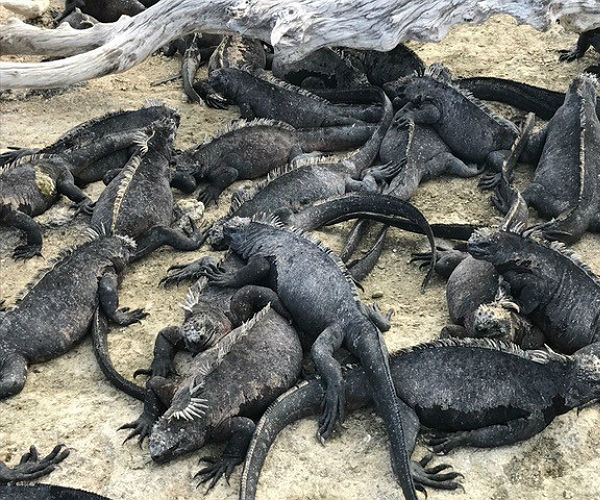 11. Santa Fe iguana
The Santa Fe land iguanas can weigh up to 11 kg and look like dragons. Although they are difficult to spot on their small home island of Santa Fe which is some distance from the other main islands it is well worth the trip.
12. Galapagos penguin
The rare Galapagos penguins are the only penguins that live on the equator, they can survive because they have adapted to the nutrient rich water in the archipelago. They can be seen on the rocks of the larger islands with their feet in the shade to avoid the heat absorbed by the black lava.
11. Santa Fe iguana
The Santa Fe land iguanas can weigh up to 11 kg and look like dragons. Although they are difficult to spot on their small home island of Santa Fe which is some distance from the other main islands it is well worth the trip.
12. Galapagos penguin
The rare Galapagos penguins are the only penguins that live on the equator, they can survive because they have adapted to the nutrient rich water in the archipelago. They can be seen on the rocks of the larger islands with their feet in the shade to avoid the heat absorbed by the black lava.
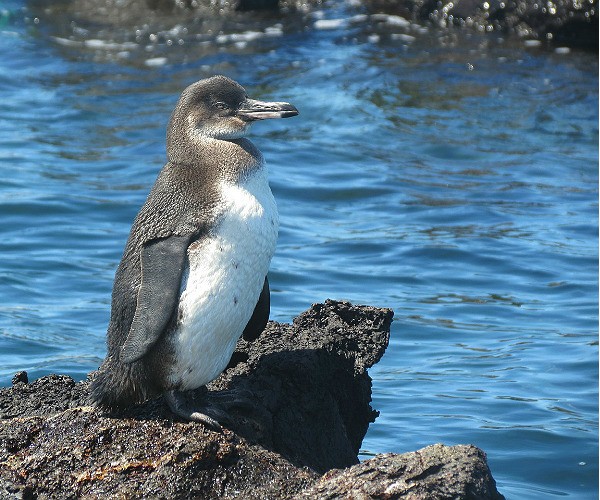 13. Galapagos sea lion
The Galapagos sea lion is indigenous to the islands and can often be seen sun bathing on land, although usually on the shores and rocks not always on a comfortable park bench. The sea lion pups are very playful and would often join us in the water while we were snorkelling to play a game of hide-and-seek, swimming towards our masks and disappearing with a flash of their tails.
13. Galapagos sea lion
The Galapagos sea lion is indigenous to the islands and can often be seen sun bathing on land, although usually on the shores and rocks not always on a comfortable park bench. The sea lion pups are very playful and would often join us in the water while we were snorkelling to play a game of hide-and-seek, swimming towards our masks and disappearing with a flash of their tails.
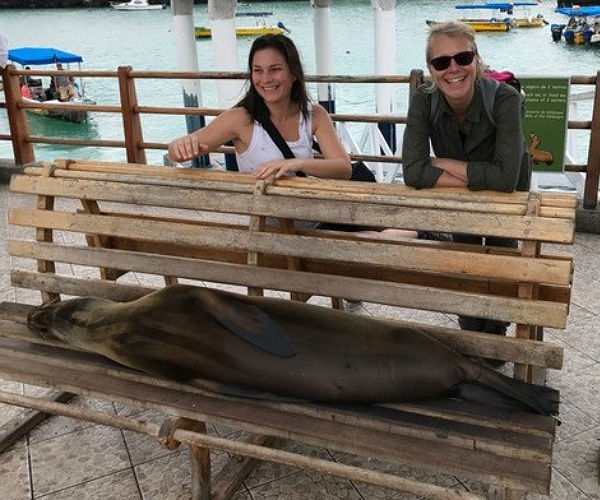 14. Galapagos fur seal
They are an endangered species and although the fur seal was close to extinction during the 1800’s due to hunting for their fur they are social animals and have no fear of man. They feed on fish and squid at night in depths of around 100 metres but oddly at full moon prefer to spend the night on land.
14. Galapagos fur seal
They are an endangered species and although the fur seal was close to extinction during the 1800’s due to hunting for their fur they are social animals and have no fear of man. They feed on fish and squid at night in depths of around 100 metres but oddly at full moon prefer to spend the night on land.
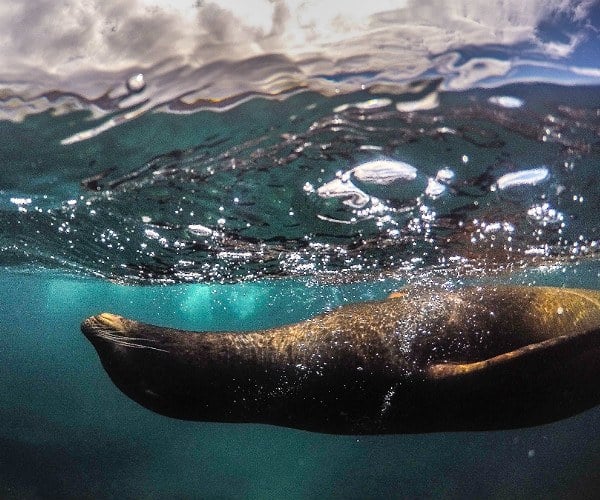 15. Galapagos giant tortoise
The Galapagos giant tortoise is the largest living species of tortoise, weighing up to 65 stones.
The traditional tortoise we think of has a dome shell, adapted for wet zones where the food is close to the ground. But those ferried across to the Galapagos on floating vegetation where the terrain was just dust quickly devoured the low hanging fruit of the cactus and were unable to reach the branches, or pads, higher up.
15. Galapagos giant tortoise
The Galapagos giant tortoise is the largest living species of tortoise, weighing up to 65 stones.
The traditional tortoise we think of has a dome shell, adapted for wet zones where the food is close to the ground. But those ferried across to the Galapagos on floating vegetation where the terrain was just dust quickly devoured the low hanging fruit of the cactus and were unable to reach the branches, or pads, higher up.
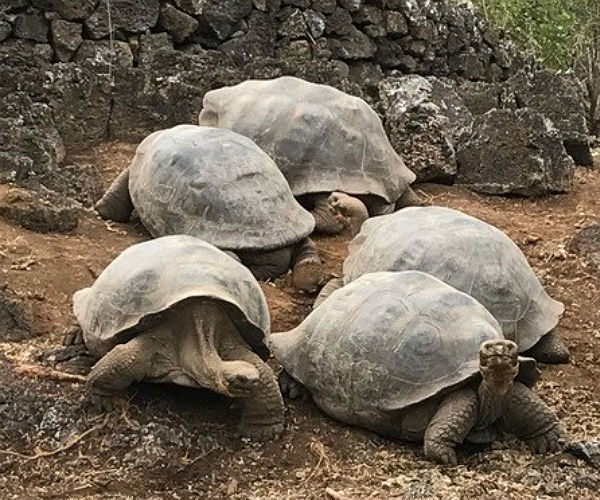 So, their shells adapted to remove the back collar and allow their neck to reach further up the cactus. They adapted to their environment and survived as a completely new species and are of course unique to the Galápagos.
A small group of us sat on the rocks in a bay on Isabela Island the largest of the Galapagos and shaped like a seahorse. We were waiting for the RIB to return as the sun set over the Pacific Ocean. There was a silence amongst us as we stared in awe at the beauty of these islands, their landscape and their inhabitants.
From our viewpoint we could see turtles, penguins, sea lions, dolphins, boobies, pelicans, frigatebirds, flightless cormorants and marine iguanas, all from that small cove, incredible. It was a poignant moment, but that’s what the Galápagos does to you, it is a beautiful and emotional experience, I wouldn’t have missed it for the world.
David Moore is Author of ‘Turning Left Around the World’. Published by Mirador and available from Amazon, it is an entertaining account of David and his wife’s travel adventures – often intriguing, frequently funny and occasionally tragic.
If you would like to be a guest blogger on A Luxury Travel Blog in order to raise your profile, please contact us.
So, their shells adapted to remove the back collar and allow their neck to reach further up the cactus. They adapted to their environment and survived as a completely new species and are of course unique to the Galápagos.
A small group of us sat on the rocks in a bay on Isabela Island the largest of the Galapagos and shaped like a seahorse. We were waiting for the RIB to return as the sun set over the Pacific Ocean. There was a silence amongst us as we stared in awe at the beauty of these islands, their landscape and their inhabitants.
From our viewpoint we could see turtles, penguins, sea lions, dolphins, boobies, pelicans, frigatebirds, flightless cormorants and marine iguanas, all from that small cove, incredible. It was a poignant moment, but that’s what the Galápagos does to you, it is a beautiful and emotional experience, I wouldn’t have missed it for the world.
David Moore is Author of ‘Turning Left Around the World’. Published by Mirador and available from Amazon, it is an entertaining account of David and his wife’s travel adventures – often intriguing, frequently funny and occasionally tragic.
If you would like to be a guest blogger on A Luxury Travel Blog in order to raise your profile, please contact us.Did you enjoy this article?
Receive similar content direct to your inbox.


All lovely animals. We visited Galapagos two months ago. Saw all of them and more. Golden rays are one notable absence from your list. Saw mating dances of flamingoes and blue footed boobies.
Thanks Charles,
Yes, I agree and I would also add the wonderful storm petrels – the birds that dance on the water.
The Galapagos 15 I refer to is the official list of the islands used by the naturalist guides, but I guess it’s there to be challenged
Is it the Galapagos penguin that you also see at Boulders Bay near Cape Town?
Hi Dave G,
It is not the same penguin but certainly related. They are banded penguins from the Spheniscidae family
Regards
David
Thanks – I just wondered they could be the same species, with them both living so far from the south pole…
Wildlife is always a great reason to visit anywhere. There sounds like there is lots of wildlife to see in this trip. So many beautiful birds I had never heard of a blue footed booby before I can’t believe how vibrant their feet are. I love seeing seals they are really lovely creatures. I would love spotting all the different wildlife you would never get bored.